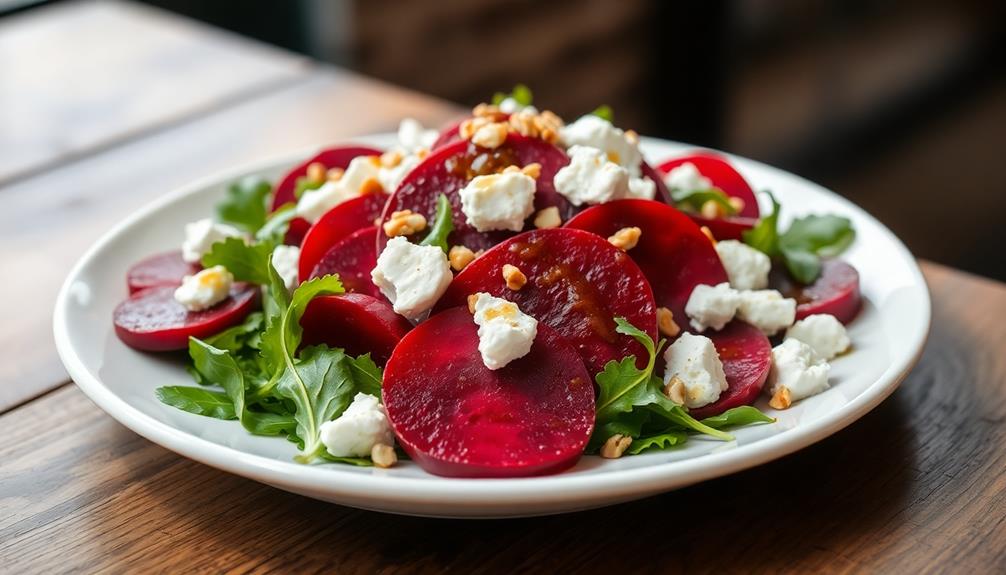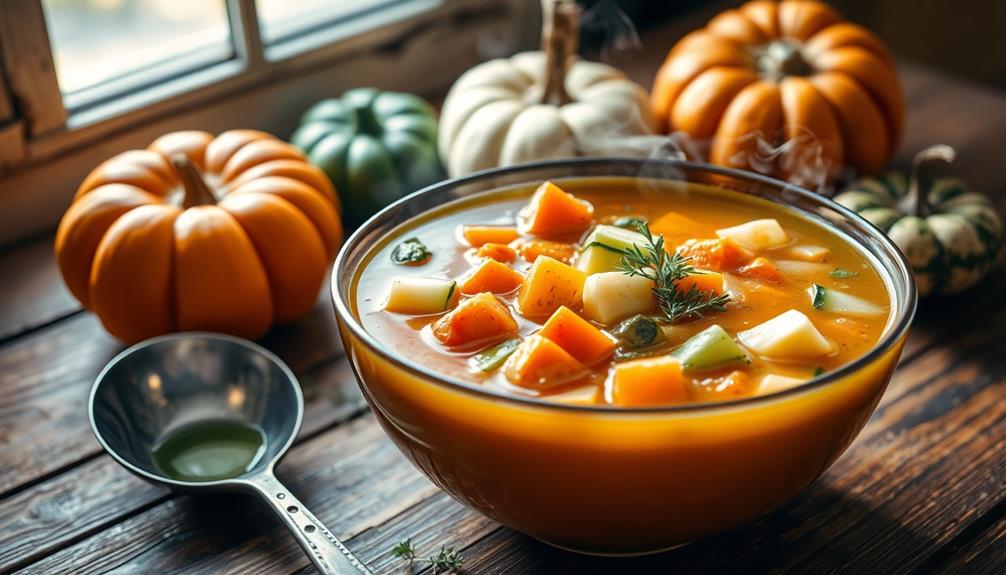You'll love this simple yet elegant Beet and Goat Cheese Salad. Start by roasting beets until they're tender and sweet. Once cooled, slice them and toss with a tangy vinaigrette. Arrange mixed greens on a plate, add the marinated beets, and crumble creamy goat cheese on top. For extra crunch, sprinkle some toasted walnuts. This colorful dish balances earthy, sweet, and tangy flavors perfectly. It's great as a light meal or impressive side dish. You can prep the beets ahead of time for quick assembly later. There's so much more to explore with this versatile salad.
Key Takeaways
- Beet and Goat Cheese Salad combines roasted beets, creamy goat cheese, mixed greens, and walnuts with a tangy vinaigrette.
- The salad offers a balance of earthy, sweet, and tangy flavors with contrasting textures and vibrant colors.
- Roasting beets enhances their natural sweetness and creates a tender texture that pairs well with creamy goat cheese.
- The dish is versatile, suitable as a starter, light meal, or side dish for various occasions.
- Variations can include different beet types, cheese substitutions, or additional ingredients like grilled chicken or salmon.
History
Over the past few decades, beet and goat cheese salad has become a staple in many high-end restaurants and trendy cafes. You might wonder how this colorful dish came to be so popular. The combination of earthy beets and tangy goat cheese isn't new, but it's gained attention in recent years.
Beets have been around for centuries, first cultivated by ancient civilizations. They've been used in salads for a long time, but pairing them with goat cheese is a more modern twist. In the 1980s and 1990s, chefs started experimenting more with fresh, local ingredients. That's when beet and goat cheese salad really took off.
You'll find that this salad often includes other ingredients like walnuts, arugula, or a balsamic dressing. These additions have evolved over time, as chefs and home cooks put their own spin on the dish. Some variations of this kale and quinoa salad recipe also incorporate dried cranberries or feta cheese for a tangy flavor. The beauty of this dish lies in its versatility; you can customize it to suit your own taste preferences. Whether you stick to the traditional ingredients or add some unique twists, this salad is a healthy and delicious option for any meal.
Today, you can find variations of beet and goat cheese salad on menus worldwide, from casual bistros to fine dining establishments. It's a testament to how simple, quality ingredients can create a timeless dish.
Recipe
This vibrant Beet and Goat Cheese Salad combines earthy roasted beets with creamy goat cheese, creating a perfect balance of flavors and textures. The sweetness of the beets is complemented by the tangy goat cheese, while a simple vinaigrette adds a zesty finish to the dish.
The salad isn't only delicious but also visually stunning, with the deep red of the beets contrasting beautifully against the white goat cheese. It's an ideal starter or light meal that's both elegant and easy to prepare, making it perfect for entertaining or a quick weeknight dinner.
- 4 medium-sized beets
- 4 oz goat cheese
- 2 cups mixed salad greens
- 1/4 cup chopped walnuts
- 2 tablespoons olive oil
- 1 tablespoon balsamic vinegar
- 1 teaspoon Dijon mustard
- Salt and pepper to taste
Preheat the oven to 400°F (200°C). Wash the beets and wrap them individually in aluminum foil. Place them on a baking sheet and roast for 45-60 minutes, or until tender when pierced with a fork. Once cool enough to handle, peel the beets and cut them into wedges.
In a small bowl, whisk together olive oil, balsamic vinegar, Dijon mustard, salt, and pepper to make the dressing. Arrange the mixed greens on a platter, top with beet wedges, crumbled goat cheese, and chopped walnuts. Drizzle the dressing over the salad just before serving.
For best results, roast the beets ahead of time and refrigerate them until ready to use. This will allow you to assemble the salad quickly when needed. If you prefer a sweeter flavor, you can add a drizzle of honey to the dressing.
To make the dish more substantial, consider adding grilled chicken or salmon. Lastly, experiment with different types of nuts or seeds, such as pumpkin seeds or pecans, to add variety to the texture and flavor of the salad.
Cooking Steps
To start making your beet and goat cheese salad, you'll need to prepare the beets.
First, preheat your oven to 400°F and wash and trim the beets. Next, wrap each beet in foil and roast them until they're tender.
Once cooled, slice the roasted beets and toss them with a tangy vinaigrette dressing to enhance their flavor.
Step 1. Preheat Oven to 400°F
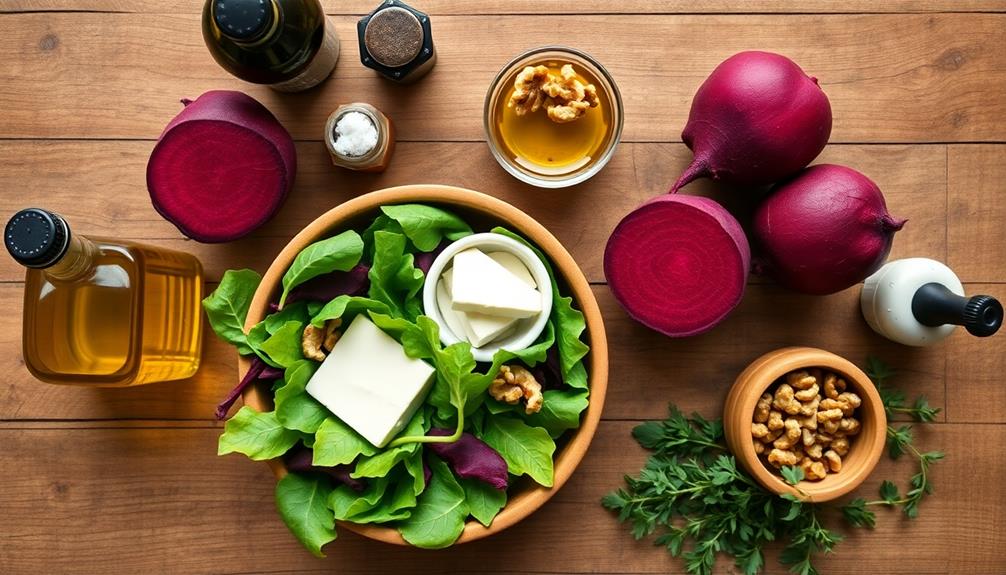
Begin by preheating your oven to 400°F (204°C). This step is crucial for ensuring your beets cook evenly and develop a rich, caramelized flavor. A properly preheated oven makes a big difference in how your beets turn out, much like how air purifiers can improve indoor air quality while you cook.
While the oven's heating up, you'll have time to prepare the other ingredients for your salad. Don't rush this step! If you're using a convection oven, you might want to lower the temperature by about 25°F, as these ovens tend to cook food faster.
While you're waiting, it's a good time to wash and trim your beets. You can also start preparing your other salad ingredients, like washing and drying your greens or slicing any additional vegetables you're using.
If you have an older oven, it might take longer to reach the right temperature. Use an oven thermometer to make sure it's actually at 400°F before you put the beets in. This extra check will help you get perfectly roasted beets every time.
Step 2. Wash and Trim Beets
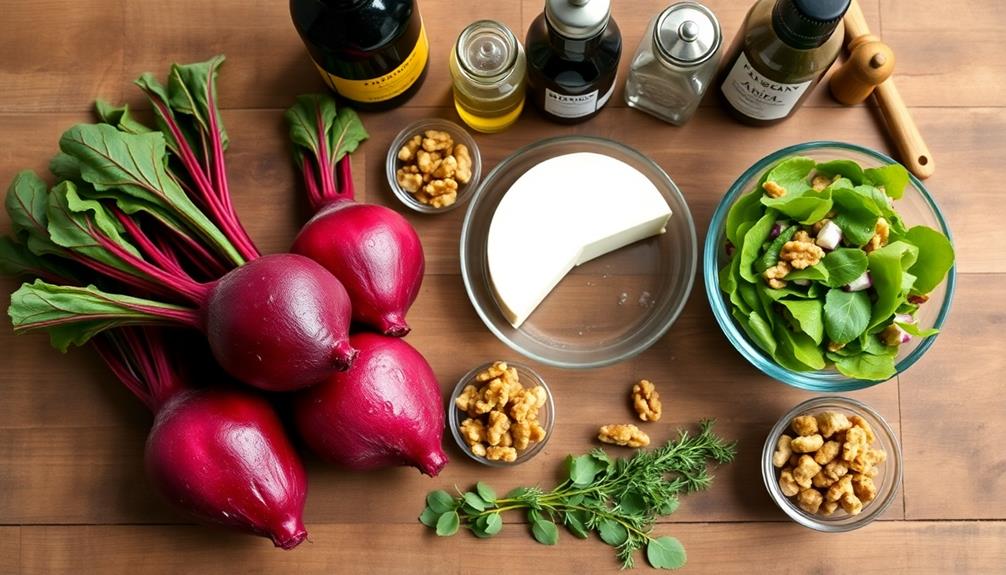
Have you ever wondered why washing and trimming beets is so important? It's a crucial step that ensures your beets are clean and ready to cook.
Start by rinsing the beets under cool running water, gently rubbing off any dirt or debris with your hands. Don't worry if some stubborn soil remains; you'll remove the skin later.
Next, it's time to trim your beets. Using a sharp knife, cut off the leafy tops, leaving about an inch of stem attached. This helps prevent the beets from "bleeding" too much during cooking.
Don't toss those greens, though! They're edible and packed with nutrients. You can save them for another dish or add them to your salad.
Now, turn your attention to the root end. Trim off the long, thin taproot, but be careful not to cut into the beet itself. You want to keep the beet's round shape intact.
If there are any small, hair-like roots, you can gently scrub them off or leave them be. They'll come off easily after cooking.
Step 3. Wrap Beets in Foil
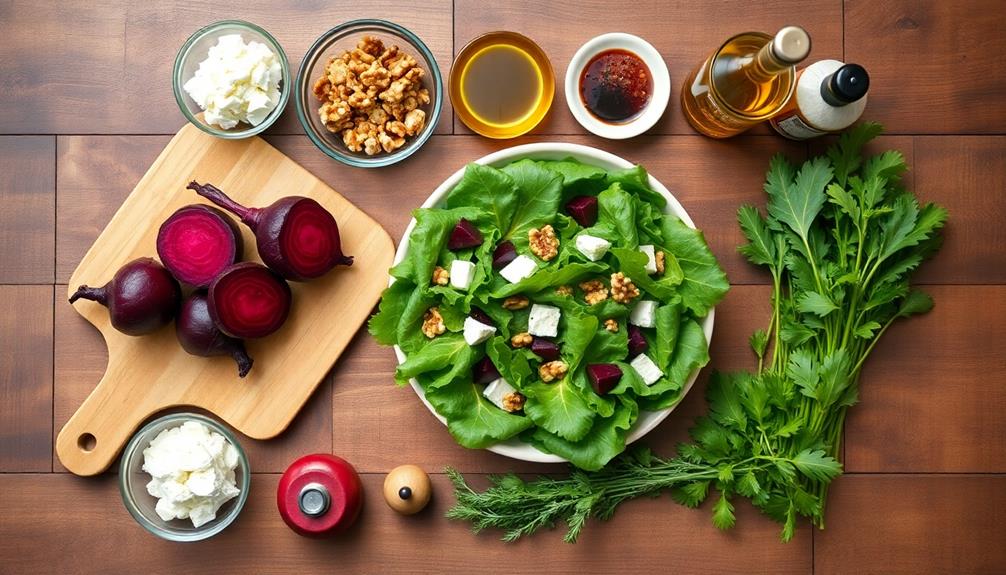
With your beets washed and trimmed, it's time to wrap them up for cooking. Grab a sheet of aluminum foil for each beet you're preparing. The foil should be large enough to completely encase the beet with some extra room. Place a beet in the center of each foil sheet.
Before you seal the foil, drizzle a little olive oil over each beet. This will help them cook evenly and add a subtle flavor. You can also sprinkle some salt and pepper if you'd like.
Now, carefully fold the edges of the foil up and over the beet, creating a tight seal. Make sure there are no openings where steam could escape during cooking.
As you wrap each beet, you're creating a mini steam chamber that'll help cook the beet to perfection. The foil keeps the moisture in, which softens the beet and intensifies its earthy flavor.
It also prevents the beet's vibrant color from bleeding onto other ingredients in your oven. Once all your beets are wrapped, they're ready for roasting. This method ensures tender, flavorful beets for your salad.
Step 4. Slice Roasted Beets
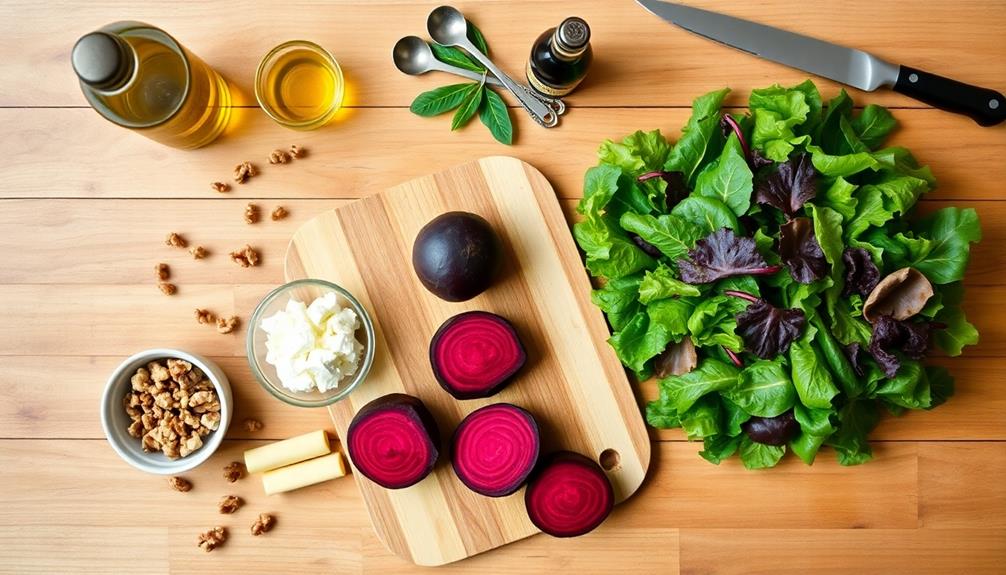
Once your beets are roasted and cool enough to handle, it's time to slice them for your salad. First, gently rub the skin off the beets with your fingers or a clean kitchen towel. Don't worry if some skin remains; it's edible and nutritious.
Next, place a beet on your cutting board and slice off the top and bottom.
Now, you'll want to cut the beets into bite-sized pieces. You can slice them into thin rounds, about 1/4 inch thick, or cut them into small cubes. If you're going for rounds, lay the beet on its side and carefully slice through it.
For cubes, first cut the beet in half, then slice each half into planks before dicing them into squares.
Step 5. Toss With Vinaigrette Dressing

Now that your beets are perfectly sliced, it's time to elevate their flavor with a zesty vinaigrette dressing. In a small bowl, whisk together 3 tablespoons of olive oil, 1 tablespoon of balsamic vinegar, 1 teaspoon of Dijon mustard, and a pinch of salt and pepper. This simple combination creates a tangy and smooth dressing that'll complement the earthy sweetness of the beets.
For those seeking a healthier lifestyle, incorporating fresh ingredients is essential, as it can lead to improved overall health and well-being, similar to the benefits provided by an air purifier in creating a cleaner living environment effective reduction of allergens.
Next, place your sliced beets in a large mixing bowl. Pour the vinaigrette over them, making sure to drizzle it evenly. Using clean hands or salad tongs, gently toss the beets to coat them thoroughly with the dressing. Be careful not to break the slices as you mix. The goal is to have each piece lightly coated, allowing the flavors to meld together.
Let the dressed beets sit for about 5 minutes. This short marinating time allows the beets to absorb the vinaigrette's flavors, enhancing their taste. Before serving, give the beets one final, gentle toss to redistribute any dressing that may have settled at the bottom of the bowl.
Final Thoughts
This flavor-packed salad is a perfect balance of earthy sweetness and tangy creaminess. You'll love how the roasted beets and creamy goat cheese complement each other, creating a dish that's both satisfying and refreshing. The vinaigrette dressing ties all the flavors together, adding a zesty kick to every bite.
Don't be afraid to experiment with this recipe. You can try different types of beets, like golden or Chioggia, for a colorful twist. If you're not a fan of goat cheese, you can substitute it with feta or even blue cheese for a different flavor profile.
Add some crunch by tossing in some toasted walnuts or pumpkin seeds. This salad is versatile enough to be served as a light lunch or as a side dish for dinner. It's perfect for impressing guests at a dinner party or brightening up your weekday meals.
Remember to prepare the beets in advance to save time when assembling the salad. With its vibrant colors and delicious taste, this beet and goat cheese salad is sure to become a favorite in your recipe collection.
Frequently Asked Questions
Can I Substitute Feta Cheese for Goat Cheese in This Salad?
Yes, you can substitute feta for goat cheese in your salad. They're both tangy and crumbly, making feta a great alternative. Keep in mind that feta's saltier, so you might want to adjust other seasonings accordingly.
How Long Can I Store Leftover Beet and Goat Cheese Salad?
You can store leftover salad in an airtight container in the fridge for up to 3 days. It's best to keep the dressing separate if possible. Consume it quickly for the freshest taste and texture.
What Wine Pairs Well With Beet and Goat Cheese Salad?
You'll find that a crisp, dry white wine pairs wonderfully. Try a Sauvignon Blanc or Pinot Grigio. If you prefer reds, go for a light-bodied option like Pinot Noir. Don't forget to chill your white wines!
Is This Salad Suitable for Vegetarians or Vegans?
You'll find this salad is perfect for vegetarians, as it doesn't contain meat. However, it's not suitable for vegans due to the goat cheese. If you're vegan, you could try substituting the cheese with a plant-based alternative.
Can I Use Canned Beets Instead of Fresh Ones?
You can definitely use canned beets instead of fresh ones. They're convenient and already cooked. Just drain and rinse them before adding to your salad. However, fresh beets might offer a better texture and flavor.
